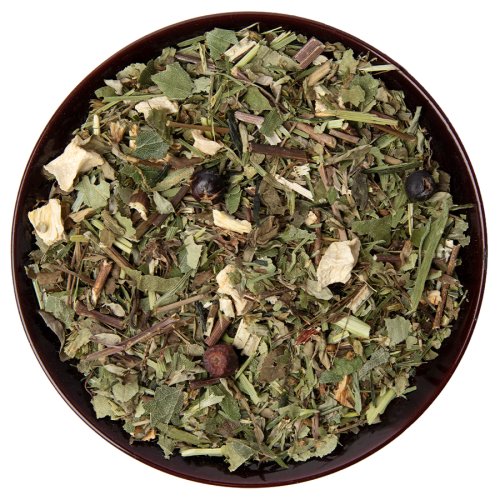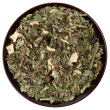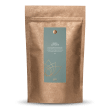Herbal infusion of gyokuro, horsetail, solidago, green oat, chanca piedra, orthosiphon, marjoram, parsley root and juniper berries.
Gyokuro Maruo
Gyokuro is considered the most noble of all Japanese green teas. In an elaborate process, the leaves of this tea are shaded for up to 30 days before harvesting, blocking up to 90% of sunlight and strongly stimulating the formation of amino acids and the preservation of as many nutrients as possible in the leaves. These give the tea its famously intense sweetness and contribute to a full, strong umami. For authentic Gyokuro, only the best leaves from the aromatic first harvest of the year are used.
Chanca Piedra
Chanca Piedra (Phyllanthus niruri) is a plant native to predominantly warm regions. In South America it is very common and has been cultivated for centuries as a traditional medicinal herb. Throughout the year, the leaves along with the stems are collected by locals in small quantities from natural plants growing in the wild. To date, more than 500 different substances have been isolated from Phyllanthus species.
Solidago
Solidago (Solidaginis virgaureae herba) is a herb that has been known and appreciated for centuries in European herbalism.
Green Oats
Green oat tea is made from the young green oat herb (Avena sativa), which is harvested before it is in full bloom. Green oats are very alkaline.
Birch Leaves
The silver birch (Betula pedula) tree belongs to the birch family (Betulaceae). There are about 40 species of birch, which are distributed across Central Europe, Asia and America. The most common at our latitudes is the silver birch, which stands out due to its black and white bark. Both the leaves and the bark of the tree have a long tradition of internal and external use.
Horsetail
Horsetail (Equisetum arvense) is mainly found in the northern hemisphere. The plant contains a high concentration of silicic acid, giving it a coarse surface which makes it an effective natural emery paper. In European botany, horsetail is also known as the silica herb.
Parsley Root
Parsley (Petroselium crispum) is widely used as a culinary herb, while its root is often used as a vegetable. The roots and leaves are also the most commonly used parts of the plant. The famous herbalist Hildegard von Bingen recommended the consumption of parsley wine, a practice which still exists today.
Orthosiphon
While some other herbs have a history of use of over a thousand years, orthosiphon (cat's whiskers) was only introduced to Europe in the 1970s. In its countries of origin, Indonesia and Australia, however, orthosiphon has been appreciated for centuries.
Marjoram
Marjoram, which translates to beauty of the mountain, was attributed to Aphrodite, the goddess of love and beauty in Greek mythology. Aphrodite praised the delicate scent of marjoram flowers as a symbol of happiness with the ability to raise people's spirits. Today, the herb is mainly used as a spice, but traditionally it was also used both externally and internally as a tea.
Juniper Berries
Juniper (Juniperus) is sometimes referred to as the herb of antiquity and is a popular spice due to its spicy and aromatic flavour.










